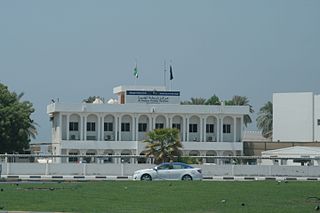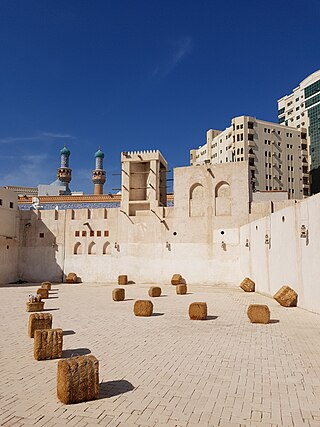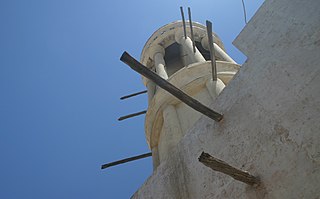
Bait Al Naboodah, Al Naboodah House, is a pearl merchant's house and museum located in the Heart of Sharjah, the restored old town and heritage area of Sharjah, United Arab Emirates (UAE).

Bait Al Naboodah, Al Naboodah House, is a pearl merchant's house and museum located in the Heart of Sharjah, the restored old town and heritage area of Sharjah, United Arab Emirates (UAE).
The house, a traditional Arabian family home based around a courtyard with almond and palm trees, was built in approximately 1845. It is an outstanding example of its style and features fine carved teak reflective of the wealth and status of its owner, the pearl merchant Obaid Bin Isa Bin Ali Al Shamsi, who was known as Al Naboodah. His family were members of the influential Al Bu Shamis tribe (Al Shamsi is the singular of Al Bu Shamis). [1] Obaid Al Naboodah had three wives. [2] He gave his name to one of the UAE's great trading families, today employing some 16,000 staff and active across aviation, construction, agriculture and logistics. [3]
Constructed from coral, gypsum and adobe, the house consists of a number of rooms around a central courtyard, with family quarters accessible separately from outside supporting extended family members as the house was expanded to accommodate his children and their respective families. [1] The house is a double story building, relatively unusual for its time and a symbol of great wealth. As well as the traditional barjeel wind towers for cooling, the house features malaqaf, wind catchers, built into the walls. [2]
Al Naboodah's majlis was located opposite the family home. He traded his pearls with markets in the UK and France but also, crucially, with India and it was the legendary wealth of the Maharajahs which was to form the mainstay of his business. This Indian trade also allowed Al Naboodah to buy great columns and doors of teak from India and ship them back to Sharjah to his ever-growing house, which was eventually to reach 10,000 metres in area. [1]
Al Naboodah was an unusually cosmopolitan figure in contemporary Sharjah, maintaining houses in Paris and Mumbai as well as his family home in what was then a relatively small, if affluent, town. [1] Like many merchants of his class, he was hit hard by the combination of the Great Depression and the growing taste for Japanese cultured pearls and watched demand for his trade dry up almost overnight. With pearling boats laid up and the entire system of trade which subsisted around pearling collapsing, the populace of Sharjah (and the other coastal emirates of the Trucial States) was faced with financial ruin, poverty and, ultimately, starvation. Although Al Naboodah was known for his generosity, times were harsh. Efforts by the British Board of Trade to find alternative markets for the Gulf's pearls failed and diversification was the only route open to many traders who would have been saddled with considerable debts throughout the slow collapse of the trade. [4]
Members of the family continued to live in the house through its long decline until the 1970s, when it was left to Sharjah Heritage. Suffering extensive water and termite damage, the house was originally restored in the 1990s and then re-opened in April 2018 following major restoration work. [5]

The United Arab Emirates is a country in the eastern part of the Arabian Peninsula located on the southeastern coast of the Persian Gulf and the northwestern coast of the Gulf of Oman. The UAE consists of seven emirates and was founded on 2 December 1971 as a federation, after UK armed forces left the region. Six of the seven emirates declared their union on 2 December 1971. The seventh, Ras al Khaimah, joined the federation on 10 February 1972. The seven sheikdoms were formerly known as the Trucial States, in reference to the truce treaties established with the British in the 19th century.

The Emirate of Sharjah is one of the emirates of the United Arab Emirates, which covers 2,590 square kilometres (1,000 sq mi) and has a population of over 1,400,000 (2015). It comprises the capital city of Sharjah, after which it is named, and other minor towns and exclaves such as Kalba', Al Dhaid, Dibba Al-Hisn and Khor Fakkan.

The national flag of the United Arab Emirates contains the Pan-Arab colors red, green, white, and black. It was designed in 1971 by Abdullah Mohammed Al Maainah, who was 19 years old at that time, and was adopted on 2 December 1971. The main theme of the flag's four colors is the unity of Arab nations. In 2008, a minor change was made to the emblem.
Al Khan is a southern suburb of the city of Sharjah, United Arab Emirates. The suburb is located on the Al Khan Bay, which serves as a boundary between Sharjah and Dubai. Until recently, the area was deserted and home to a collection of crumbling traditional coral and adobe houses, but it now houses the Sharjah Aquarium. A number of the older buildings are being restored to create a heritage area.

Ajman is the capital of the emirate of Ajman in the United Arab Emirates. It is the fifth-largest city in UAE after Dubai, Abu Dhabi, Sharjah and Al Ain. Located along the Persian Gulf, it is engulfed by the larger emirate of Sharjah in territory.

Sheikh Saeed bin Maktoum bin Hasher Al Maktoum was the longest-serving Ruler of Dubai, from 1912 until his death in 1958. He presided over Dubai during the end of the pearling boom and through the long and difficult recession that followed the collapse of the pearling market, transforming Dubai into an active trading hub which developed new markets and economic opportunities.

The Al Nuaimi family is the ruling royal family of Ajman, one of the seven emirates that together comprise the United Arab Emirates (UAE).
The Al Bu Shamis or Al Shawamis is an Arab Bedouin tribe that mostly inhabit the southeastern part of the Arabian peninsula. They are located mainly in Northern Oman, the United Arab Emirates, and to a lesser extent Kuwait, Qatar, eastern Saudi Arabia, Bahrain and Iraq. Due to the large nature of the tribe, there are today in fact many branches that trace themselves to the Al Bu Shamis tribe.
The Trucial Oman Scouts was a paramilitary force that the British raised in 1951 as the Trucial Oman Levies, to serve in the Trucial States. In 1956, the Levies were renamed the Trucial Oman Scouts. In 1971, upon the formation of the United Arab Emirates (UAE), the scouts were handed to the United Arab Emirate's government and formed its Federal Union Defence Force (UDF) which is today renamed as the United Arab Emirates Armed Forces.

The Trucial States, also known as the Trucial Coast, the Trucial Sheikhdoms, Trucial Arabia or Trucial Oman, was the name the British government gave to a group of tribal confederations to the south of the Persian Gulf whose leaders had signed protective treaties, or truces, with the United Kingdom between 1820 and 1892.

Al Heera is a suburb in Northern Sharjah in the United Arab Emirates, traditionally home to the Darawishah, part of the Al Bu Shamis section of the Na'im tribe. At one stage declaring its independence from Sharjah, with its own Sheikh, it formally became part of the Emirate of Sharjah in 1942 on the death of its Ruler, Abdulrahman Al Shamsi. A coastal settlement with a small harbour formerly used by a number of fishermen and pleasure boat owners, its main distinguishing feature today is its police station, converted in 2019 into the 'Al Heera Literature Society' building.
Sheikh Sultan II bin Saqr Al Qasimi was the Ruler of Sharjah, a Trucial State and now one of the United Arab Emirates, from 1924 to 1951. His father having ceded the rule of Sharjah to Khalid bin Ahmad Al Qasimi, Sultan found himself dispossessed and married the daughter of Abdulrahman bin Shamsi, the headman of Al Heera. Buoyed by Khalid's unpopularity and Abdulrahman's force of personality and arms, Sultan deposed Khalid and became Ruler of Sharjah. However, he found the interior of the country dominated by Bedouin tribes and the East coast increasingly dominated by the former Ruler, Khalid bin Ahmad, leaving Sultan the effective ruler of a cluster of coastal settlements, many of which constantly tried to secede from his rule. He is cited as having presided over a low ebb in the power of the Al Qasimi, formerly a powerful maritime federation.
Sheikh Rashid bin Humaid Al Nuaimi was the Ruler of Ajman, one of the Trucial States which today form the United Arab Emirates (UAE), from 1816–1838, leading a force of 50 men to take control of the town from members of the Al Bu Shamis tribe who had settled there and also at Al Heera. At the time, Ajman was a dependency of Sharjah. Five years after his establishment at Ajman, the fort was taken by the Darawisha Bedouin who were removed by the action of the Ruler of Sharjah, Sheikh Saqr bin Sultan Al Qasimi.
The Na'im is an Arab tribe in the United Arab Emirates. The tribe is also present in other gulf countries.
Humaid bin Abdulaziz Al Nuaimi was Ruler of Ajman, one of the Trucial States which today form the United Arab Emirates (UAE), from 1910–1928. His rule was marked by a running conflict with the Al Bu Shamis and their charismatic Sheikh, Abdulrahman bin Muhammad Al Shamsi.
The Buraimi dispute or Buraimi war was a series of covert attempts by Saudi Arabia to influence the loyalties of tribes and communities in and around the oil-rich Buraimi oasis in the 1940s and 1950s, which culminated in an armed conflict between forces and tribes loyal to Saudi Arabia, on one side, and Oman and the Trucial States, on the other, which broke out as the result of a territorial dispute over the town of Al-Buraimi in Oman, and parts of what is now the city of Al Ain in the Eastern Region of the Emirate of Abu Dhabi, the UAE. It amounted to an attempted Saudi invasion of the Buraimi Oasis. Its roots lay in the partitioning of tribal areas and communities which took place in the Trucial States when oil companies were seeking concessions to explore the interior.
The Mazari is a tribe of the United Arab Emirates (UAE). The Mazari settled throughout the Trucial States but principally in Abu Dhabi. They are considered a subsection of the Bani Yas and formed the majority of the Bedouin component of that federation of tribes.

The Heart of Sharjah is a cultural heritage project that aims to preserve and restore the old town of Sharjah in the United Arab Emirates (UAE) and return it to its 1950s state.

Ibrahim Bin Mohammed Al Midfa was the first journalist in Sharjah, United Arab Emirates, producing a handwritten news sheet called Oman newspaper in 1927. A prominent local intellectual at the time, he presided over regular meetings of local writers, poets and political activists at a time when British influence and presence in the Trucial States was beginning to be questioned by local community leaders.
Abdulrahman bin Muhammad Al Shamsi was the Sheikh, or head man, of the township of Al Heera, today a suburb of Sharjah in the United Arab Emirates. A highly influential and often divisive figure in regional politics during the early 20th century in the Trucial States, he was referred to by one British Political Resident as ‘a stormy petrel of the Trucial Coast, a man feared by everyone in and around Sharjah’.